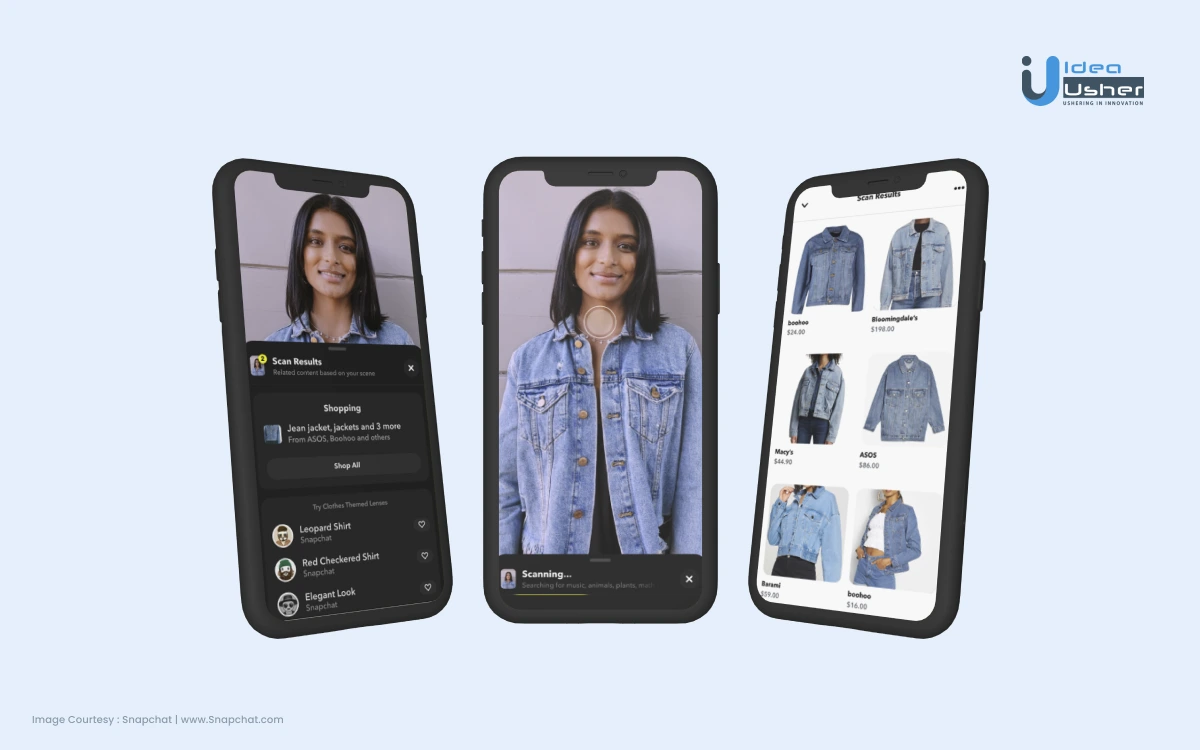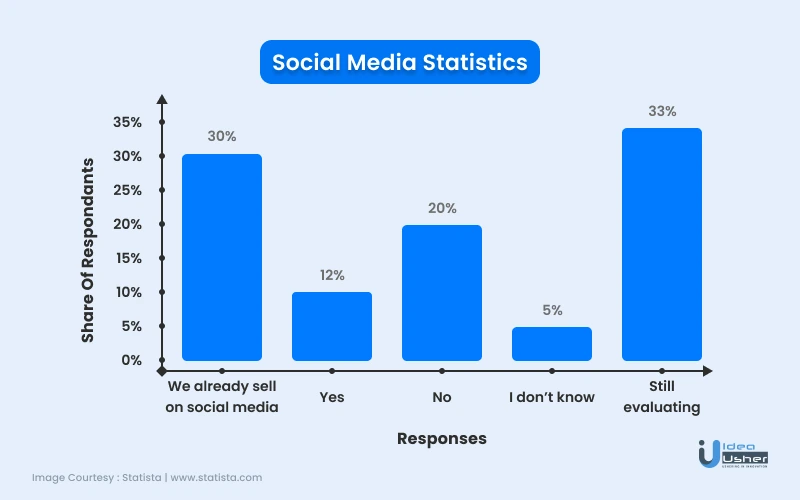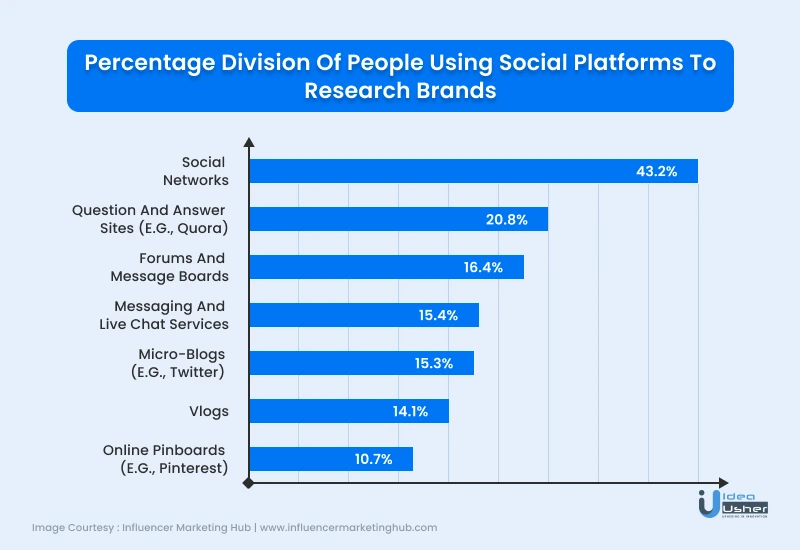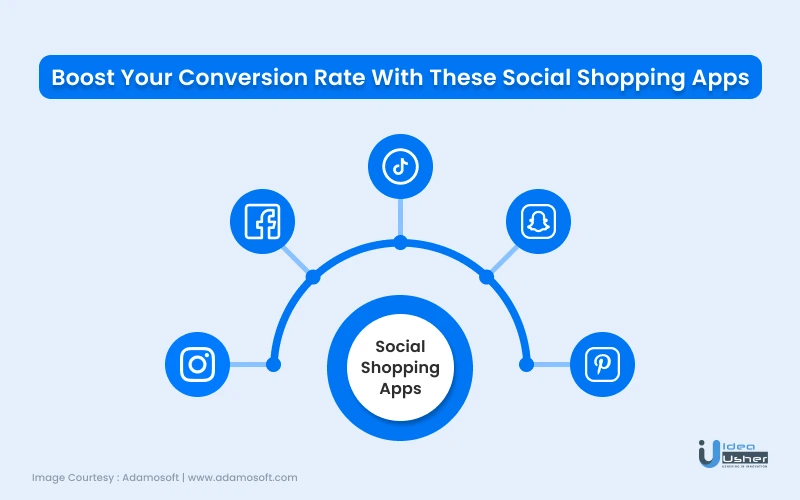App Development, Blog, E-Commerce, shopping app
Social Shopping App Development: Statistics & Strategies
- Why Social Commerce Now?
- How Social Media Shopping Is Different From eCommerce?
- Why do you need to get a Social Shopping App developed?
- Online Shopping Social Media Strategies: What Are They?
- Boost Your Conversion Rate With These Social Shopping Apps
- Build Your Own Social Media Shopping App With Idea Usher
- Final Words
- FAQ

Social media shopping is no longer the future of eCommerce; it already *is* eCommerce! According to Statista, 42% of global internet users have purchased a product after seeing it on social media. That accounts for being almost half of the world’s online population. My It Things, Polyvore, Wanelo, Open Sky etc. are some of the great examples of social shopping app development. Said that as a retailer, you need to know how to leverage those platforms if you want to survive in the 21st century.
To make you aware, let’s walk through the social media shopping statistics and strategies that will help you leverage your profits and remain ahead in this cutting edge competition by investing in social shopping app development!
- Why Social Commerce Now?
- How Social Media Shopping Is Different From eCommerce?
- Why do you need to get a Social Shopping App developed?
- Online Shopping Social Media Strategies: What Are They?
- Boost Your Conversion Rate With These Social Shopping Apps
- Build Your Own Social Media Shopping App With Idea Usher
- Final Words
- FAQ
Why Social Commerce Now?

Did you know that people spend more than twice as much time on social media as they do email?
In fact, it’s estimated that by 2022, the average person will spend about four hours a day on social media.
If you’re looking for ways to connect with customers and drive sales, social media should be your go-to. But growing your brand on social media isn’t all about posting cute pictures and gifs—there are real numbers behind social commerce.
Here are a few statistics that are worth taking into consideration:
- Over the past few years, Social commerce has grown dramatically. Some sources say that 80% of social media users there have made a purchase through a social media platform. That’s huge! And even in the United States, where we’re not quite as gung-ho about social shopping, we’ve still got 40% of us buying products through social platforms.
- 30% of people are likely to make purchases from social media platforms, revealed a survey conducted by BigCommerce.
- 72% of shoppers use social media platforms to research products before making a purchase, a stat gathered by Influencermarketinghub.
- 91% of people say they access Facebook at least once a day, though many people access their accounts multiple times per day.
- A report by Instagram states that 60% of people attested to discover new products on this platform.
- A 2021 Statista report stated that 30% of eCommerce companies are already making profit by selling on social media. And 12% more are planning on making social media platforms the selling channels in coming years.
These numbers say enough of how social media shopping apps are going to be the next big thing in eCommerce. Thus, these statistics are a foolproof indication of how social shopping app development will turn the tables for several eCommerce companies.
How Social Media Shopping Is Different From eCommerce?
Here’s quick rundown through the key differences between social media shopping and eCommerce:
| Social Media Shopping | eCommerce | |
| Definition | Social media is all about personal engagement and building relationships. It’s not a place to sell your products or services directly. | Ecommerce is about transactions and moving customers through the sales funnel at all times. |
| Goal | The goal of a social media platform is to create brand awareness and keep users engaged so they can help publicize your product for you. It’s about creating an engaged community. | It is to get users from their first visit on your site, through stages like comparing different offers, adding items to their cart, making the transaction |
| Interaction | Highly interactive | Less interactive |
| Platforms | Pinterest, Facebook, Instagram, etc. | Amazon, Sephora, BodyShop, etc. |
| Consumer Path | ViewProduct→Add To Cart→Purchase | Ad Clicked/Website, App Visit →View Product→Add To Cart→ Payment Details→ Checkout → Purchase |
Why do you need to get a Social Shopping App developed?

Social media shopping statistics show that 30% of customers confessed that they would buy goods directly from social media platforms. Additionally, a 2021 report by Statista states that the number of the US online shoppers is predicted to grow to 108 million by 2025, which was 79 million in 2020. That’s not a small number, indicating support from the customer base.
In fact, according to recent figures from social media shopping appp statistics, social media is now one of the most popular channels in which consumers say they discover new products, encouraging them to buy.
Social media shopping apps aren’t just influencing online shopping; it’s actually an integral part of customers’ research and shopping journeys today. Said that the modern online shopper craves convenience above all else. They expect a personalized shopping experience. All this got sorted when companies leveraged social media and converted it into social commerce.
Here’s an list of benefits that social media shopping apps have made to users:
- The buying journey has been made seamless by social media.
- Users see an ad, click on it, and buy the item right then and there.
- Or maybe they’re scrolling through their social media feed and find something that piques their interest—and just like that, another purchase is made.
- Now, they don’t have to spend time searching through an abundance of products or waiting in lines.
To ensure that shoppers get what they need in a hassle-free way, online retailers are relying on social commerce apps that connect customers based on similar interests or needs. As a result, social shopping app development is on the peak.
Online Shopping Social Media Strategies: What Are They?
Let’s take a look at how social media is shifting online shopping trends—and what this means for your business if you want to keep up in the e-commerce space.
Strategy 1: Target Engagement; Not Sales
Marketers who want to ensure their social media channels succeed should focus on building relationships with customers before they go on a sales pitch. This may seem like counterintuitive advice but it is imperative to remember that the primary intent with which people visit social media is not shopping.
Marketers must hold the hands of social media to build relationships. They should focus on sharing engaging information, building trust and focusing on customer feedback. Also, priority should be given to engagement over any sales efforts on social media. Consistent interaction through good content on social media will eventually lead the consumer to a product purchase.
Strategy 2: Social Listening
Social listening is an important part of any business’s social media strategy. It’s the process of tracking online conversations about your brand, whether the mentions are in the form of tags, hashtags, reviews or simple comments.
If you don’t already have a social listening strategy in place, it’s time to get on it! Here are some of the top reasons why your e-commerce business should be using social listening:
- It allows you to learn what your customers like and dislike about your company.
- You figure out what your customers are actually looking for.
- Learn which of your clients’ complaints require immediate attention.
- Remain ahead of your competitors by getting insights into customer’s behavior.
Strategy 3: Social Media Paid Advertising
This strategy is the key to increasing your reach. Social media platforms offer an assortment of advertisement options. Sprout Social, a leading social media and content marketing consulting company, has recently offered insights into the usage of Facebook and Instagram ads by marketers. Their research shows that 89% of marketers use Facebook in their brand marketing efforts.
The use of Facebook ads at such a massive scale by marketers confirms that social media ads are extremely valuable in increasing engagement and reach rates. Make sure the audience resonates with your selected platform before making an investment in any social media channel.
Strategy 4: Leverage the Power of Data
Marketers today are more focused on making the customer journey seamless and uncluttered with the right use of analytics. While it is true that social media platforms have inherent analytics tools like Facebook Insights, YouTube Analytics, etc., you can make your own way by leveraging the power of data that is already out there. You can track your audience’s thought process, buying behavior, attribution and a lot of other aspects which lets you monitor your paid advertising campaigns.
With all the data and analytics you have at your disposal, you are able to make intelligent decisions based on real-time data.
Strategy 5: Embrace the Emerging Platforms
It may seem like our world is dominated by Facebook, Instagram, Twitter and other big social media networks that are well known in the Western world. But there are plenty of other social platforms out there for marketers to consider, all having their own strengths and weaknesses when it comes to marketing potential. So, the key is knowing your audience. If you know who your target customers are, then this will make it much easier for you to determine what type of platform would work.
However, one must keep on embracing the new platforms which are constantly popping up to remain ahead in the curve. Also, you must be considerate that when you start something from scratch, always keep the demographics in mind. Therefore, it’s important to remember that what’s popular today may not be popular tomorrow.
Boost Your Conversion Rate With These Social Shopping Apps
Ironically, social media isn’t just for communication and entertainment anymore—it’s for shopping, too. The ecommerce industry has become a part of the social media app ecosystem with the birth of social commerce apps.
Let’s take a look at how these apps work and what trends you should be aware of as you develop your own social shopping app:

Penned as one of the most popular social networking sites around the globe! Instagram is a mobile and desktop internet-based photo-sharing social application. It allows users to share pictures and videos either publicly or privately to pre-approved followers. It also has several features that make it a good place to do social shopping. Instagram’s business tools allow retailers to tag products in their posts.
Instagram also lets you create shoppable ads so your followers can shop directly from your images without leaving the app at all! Online stores like Chico’s have easily synced the product catalog with Facebook and Instagram. This allows users to tag the exact items in their posts so that customers can see what’s available for purchase and be directed exactly where they need to go for checkout!
Facebook is the social media platform with the largest active user base, with 2.6 billion monthly users. As such, it’s a great place to reach a wide audience. It’s best suited for older audiences; in fact, 83% of adults aged 25-54 use Facebook. It has a wide range of targeting options that make it easy to reach your intended audience, including location and interests targeting, among others.
It also has a lot of e-commerce features: Facebook Marketplace allows you to sell directly to friends and followers; you can create advertisements within the platform; and its buy button lets visitors purchase items from your website without leaving their feed—meaning the shopper doesn’t have to go searching for your product on Google.
Snapchat
Snapchat is a unique social media platform in that it allows you to get creative with your product placement. A great way to use Snapchat for social shopping is to create an exclusive promo code or coupon to share with just your Snapchat followers, the same way you might on Facebook.
You can also use Snapchat for more interactive ways of showcasing products. For example, if you sell clothes and want followers to see how clothing fits on different body types in real life, consider asking a customer or influencer to model the items for their Snapchat following rather than spending money on professional models and photoshoots.
Pinterest is arguably the best social shopping app for connecting with people. It enables you to follow your friends, family members and influencers (and their pins). You can also repin products shared by other pinners. It’s also a great way to discover new products shared by other users based on your interests.
The platform tends to attract a female audience, so it’s ideal for promoting beauty and fashion products, food recipes and lifestyle products. However, it’s not just limited to brands as it’s also a great place for influencers and bloggers to connect with their target audiences, as well as artists, brands and celebrities who can showcase their artworks or latest projects.
TikTok
TikTok is a short-form video platform that allows users to create and share 15-second videos. The platform has been described as the “fastest growing social media app” and it reached 500 million active users in only 2 years.
To start selling on it you’ll need an online store (ecommerce site) where you can list your products. You can build one yourself with Shopify or Wix if you’re looking for a DIY option, or we can help set up a store for you. Once your store is ready you’ll need to connect it to your TikTok account so the app knows which products to display when someone clicks on the link in your bio. When people click through they will be taken directly to the page of your product on your store so they can make purchases right away!
Build Your Own Social Media Shopping App With Idea Usher
As per the reports of eMarketer, the number of social commerce buyers in the US grew to 80.1 million in 2020. Also, it predicted that the number will reach 96.1 million in 2022. That means you can’t afford to miss out on this trend if you want your business to stay relevant. In fact, you probably can’t afford to miss out on this trend if you want your business to stay afloat.
The good news is that Idea Usher can help. With our help, you can build an easy-to-use social media shopping app. It will integrate with popular social media platforms like Instagram, Facebook, and Pinterest. In no time, you’ll be able to give your customers a seamless experience when they shop online.
With Idea Usher, you can put your idea on the fast track from dream to reality. So, connect with our developers today and build exactly what you want.
For more information and a detailed understanding of the social shopping app development process, you can contact them at.
E-mail: [email protected]
Phone Numbers : (+91)9463407140, (+91)8591407140, and (+1)7329624560
Build Better Solutions With Idea Usher
Professionals
Projects
Final Words
Nearly 2 billion people worldwide use Facebook’s family of apps every day. Instagram has 1 billion monthly active users (MAUs), and TikTok has 800 million MAUs (including 500 million MAUs in China). For comparison, Amazon has 150 to 200 million MAUs and eBay has around 100 million MAUs globally. These numbers indicate that making an investment in building your own social media shopping app is a worthwhile endeavor. And one that will pay off handsomely if you get in early enough!
It’s still early days for social commerce. The concept and statistics are new, and the experience is different from traditional e-commerce. Shopping on social media is more about browsing and interacting with friends than it is about buying stuff. As a result, the apps that provide this functionality are still evolving. As you can imagine, expectations for what makes a good shopping app are quite different from standard e-commerce transactions. So if you’re thinking of using Instagram or Facebook to shop, keep in mind this is all still new territory; there’s a lot of room to learn and improve here.
FAQ
Here are some interesting FAQs on social shopping app development
Q. What role does social media play in e-Commerce?
A. For ecommerce websites, social networking is a powerful tool. It’s quite important to be able to not only guide users to a new product or an appealing price. But also to engage with them and establish a sense of community.
Q. What is the advantage of social shopping app development ?
A. The social shopping app development makes it possible for retailers to share their latest products, offers and deals. This can be done on various social media platforms like Facebook, Instagram etc. This benefits in increasing sales, profits and brand name value.
Q. How much time is required to build a social commerce app?
A. There are many aspects , so it’s rather difficult to answer this question of how long it will take.
That would depend on the
- extent of the functionality you desire
- brand connection channels required
- app functionalities and features
- any other requirements you may have
What we can say is that we are able to deliver results extremely fast.
Related posts:
- The best way to easily start mobile shopping app development
- How To Begin With Mobile Shopping App Development
- Best Online Shopping Websites in the world: Our Ideal Review
- How To Clone The Ntwrk Shopping App? An Expert View
- Social media: The most powerful advertising tool to leverage your salon business
- Mobile App Development for Digital Real Estate: Trading Strategies
Powered by YARPP.
Love to play with words, I hail from a tech background that justifies why I aptly know how to whittle a topic down to its bare essence and build on the same. From everyday writing to being an avid tech follower, I connect with anyone and everyone through my words. Other than words, travelling, cooking and watching movies makes me happy.
Hire the best developers
100% developer skill guarantee or your money back. Trusted by 500+ brands

Contact Us
- SCF 98, Phase 11, Sector-67 Mohali, 160062
- 651 B Broad St, Middletown, 19709, county New Castle Delaware, USA
- [email protected]
- (+1) 628 432 4305
HR contact details
Follow us on

Idea Usher is a pioneering IT company with a definite set of services and solutions. We aim at providing impeccable services to our clients and establishing a reliable relationship.
Our Partners
Contact Us
- SCF 98, Phase 11, Sector-67 Mohali, 160062
- 651 B Broad St, Middletown, 19709, county New Castle Delaware, USA
Follow us on

Idea Usher is a pioneering IT company with a definite set of services and solutions. We aim at providing impeccable services to our clients and establishing a reliable relationship.







Kamalpreet Kaur